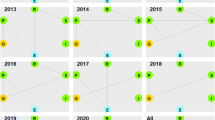Abstract
Innovations, be they radical new products or technology improvements, are widely recognized as a key factor of economic growth. To identify the factors triggering innovative activities is a main concern for economic theory and empirical analysis. As the number of hypotheses is large, the process of model selection becomes a crucial part of the empirical implementation. The problem is complicated by unobserved heterogeneity and possible endogeneity of regressors. A new efficient solution to this problem is suggested, applying optimization heuristics, which exploits the inherent discrete nature of the model selection problem. The method is applied to Russian regional data within the framework of a log-linear dynamic panel data model. To illustrate the performance of the method, we also report the results of Monte-Carlo simulations.
Similar content being viewed by others
References
Acemoglu D., Aghion P., Zilibotti F. (2003) Vertical integration and distance to frontier. Journal of the European Economic Association 1(2-3): 630–638
Arellano M., Bond S. (1991) Some tests of specification for panel data: Monte Carlo evidence and an application to employment equations. Review of Economic Studies 58(2): 277–297
Bacchiocchi E., Montobbio F. (2009) Knowledge diffusion from university and public research. A comparison between US, Japan and Europe using patent citations. Journal of Technology Transfer 34(2): 169–181
Blundell R., Bond S. (1998) Initial conditions and moment restrictions in dynamic panel data models. Journal of Econometrics 87(1): 115–143
Blundell R., Griffith R., Reenen J. V. (1999) Market share, market value and innovation in a panel of British manufacturing firms. Review of Economic Studies 66: 529–554
Breiman L. (2001) Statistical modelling: The two cultures. Statistical Science 16(3): 199–231
Bucci A., Parello C. (2009) Horizontal innovation-based growth and product market competition. Economic Modelling 26(1–2): 213–221
Cainelli G., Evangelista R., Savona M. (2006) Innovation and economic performance in services: A firm-level analysis. Cambridge Journal of Economics 30(3): 435–458
Crescenzi R., Rodriguez-Posa A., Storper M. (2007) The territorial dynamics of innovation: A Europe-United States comparative analysis. Journal of Economic Geography 7(6): 673–709
Dezhina I., Shelubinskaya N., Pipiya L., Ivanova N. (2008) Innovation policy analysis and appraisal of its results (in Russian). Innovations 5(115): 56–72
Fogel D. (2006) Evolutionary computation: Toward a new philosophy of machine intelligence. Wiley-IEEE Press, Hoboken, NJ
Forrest J. (1991) Models of the process of technological innovation. Technology Analysis & Strategic Management 3(4): 439–453
Funk M. (2006) Business cycles and research investment. Applied Economics 38: 1775–1782
Gatu C., Kontoghiorghes E., Gilli M., Winker P. (2008) An efficient branch-and-bound strategy for subset vector autoregressive model selection. Journal of Economic Dynamics & Control 32: 1949–1963
Gilli M., Winker P. (2009) Heuristic optimization methods in econometrics. In: Belsley D., Kontoghiorghes E. (eds) Handbook of computational econometrics. Wiley, Chichester, pp 81–119
Hausman J., Taylor W. (1981) Panel data and unobservable individual effects. Econometrica 49(6): 1377–1398
Hendry D., Krolzig H. (2005) The properties of automatic “GETS” modelling. The Economic Journal 115(502): C32–C61
Hsu N. J., Hung H. L., Chang Y. M. (2007) Subset selection for vector autoregressive processes using lasso. Computational Statistics & Data Analysis 52(7): 3645–3657
Jefferson G., Hu A., Guan X., Yu X. (2003) Ownership, performance, and innovation in China’s large- and medium-size industrial enterprise sector. China Economic Review 14(1): 89–113
Kapetanios G. (2007) Variable selection in regression models using nonstandard optimization of information criteria. Computational Statistics & Data Analysis 52(1): 4–15
Kaucic M. (2009) Predicting EU energy industry excess returns on EU market index via a constrained genetic algorithm. Computational Economics 34: 173–193
Klotz S. (1997) Econometric models with spatial autocorrelation—an introductory survey. Journal of Economics and Statistics 218(1+2): 168–196
MacGarvie M. (2001) The determinants of international knowledge diffusion as measured by patent citations. Economics Letters 87: 121–126
Merivate E., Pernias J. (2006) Innovation complementarity and scale of production. Journal of Industrial Economics 54(1): 1–29
Okui R. (2009) The optimal choice of moments in dynamic panel data models. Journal of Econometrics 151(1): 1–16
Penrose R. (1956) On best approximate solutions of linear matrix equations. Proceedings of the Cambridge Philosophical Society 52(1): 17–19
Perez-Amaral T., Gallo G., White H. (2003) A flexible tool for model building: The relevant transformation of the inputs network approach (RETINA). Oxford Bulletin of Economics and Statistics 65(1): 821–838
Polterovich V. (2009) The problem of creating a National Innovation System (in Russian). Economics and Mathematical Methods 45(2): 3–18
Porter M. (2003) The economic performance of regions. Regional Studies 37(6-7): 549–578
Rautava J. (2005) BOFIT Russia Review Yearbook 2005. Bank of Finland, Helsinki
Rosenberg N., Landau R., Mowery D. (1992) Technology and the wealth of nations. Stanford University Press, Stanford, CA
Savin, I. (2010). A comparative study of the lasso-type and heuristic model selection methods. Tech. Rep. 42, COMISEF Working Papers Series.
Savin, I., & Winker, P. (2010). Heuristic optimization methods for dynamic panel data model selection. Application on the Russian innovative performance. Tech. Rep. 27, COMISEF Working Papers Series.
Schumpeter J. (1943) Capitalism, socialism and democracy. Allen Unwin, London
Shinohara K., Okuda H. (2010) Dynamic innovation diffusion modelling. Computational Economics 35: 51–62
Sin C. Y., White H. (1996) Information criteria for selecting possibly misspecified parametric models. Journal of Econometrics 71(1–2): 207–225
Sölvell O. (2008) Clusters—balancing evolutionary and constructive forces. Ivory Tower Publishers, Stockholm
Tytell, I., & Yudaeva, K. (2006). The role of FDI in Eastern Europe and New Independent States. Tech. rep., Centro Studi Luca d’Agliano Development Studies Working Paper No. 217, Milan.
Vinogradov B. (2008) Certain aspects of staffing for defensive-industrial complex (in Russian). Innovations 7(117): 23–29
Winker P. (1999) Causes and effects of financing constraints at the firm level: Some microeconometric evidence. Small Business Economics 12: 169–181
Winker P. (2000) Optimized multivariate lag structure selection. Computational Economics 16: 87–103
Winker P. (2001) Optimization heuristics in econometrics: Applications of threshold accepting. Wiley, Chichester
Author information
Authors and Affiliations
Corresponding author
Rights and permissions
About this article
Cite this article
Savin, I., Winker, P. Heuristic Optimization Methods for Dynamic Panel Data Model Selection: Application on the Russian Innovative Performance. Comput Econ 39, 337–363 (2012). https://doi.org/10.1007/s10614-010-9243-x
Accepted:
Published:
Issue Date:
DOI: https://doi.org/10.1007/s10614-010-9243-x




